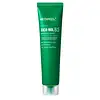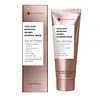What's inside
What's inside
 Key Ingredients
Key Ingredients

 Benefits
Benefits

 Concerns
Concerns

 Ingredients Side-by-side
Ingredients Side-by-side

Water
Skin ConditioningSimmondsia Chinensis Seed Oil
EmollientPolyvinyl Alcohol
Methylpropanediol
SolventButylene Glycol
HumectantCaprylic/Capric Triglyceride
Masking1,2-Hexanediol
Skin ConditioningNiacinamide
SmoothingAlanine
MaskingPolyglyceryl-10 Oleate
Skin ConditioningPolysorbate 80
EmulsifyingPullulan
Centella Asiatica Flower/Leaf/Stem Extract
Skin ConditioningSphingomonas Ferment Extract
Skin ConditioningHydrolyzed Safflower Flower Extract
Skin ConditioningGardenia Taitensis Callus Extract
AntioxidantCentella Asiatica Extract
CleansingAngelica Archangelica Extract
Skin ConditioningTerminalia Ferdinandiana Fruit Extract
AntioxidantPyrus Malus Fruit Extract
Skin ConditioningCarica Papaya Fruit Extract
Skin ConditioningVitis Vinifera Fruit Extract
Skin ConditioningHydrogenated Lecithin
EmulsifyingGlyceryl Stearate
EmollientPEG-100 Stearate
Panthenol
Skin ConditioningDisteardimonium Hectorite
StabilisingSodium Polystyrene Sulfonate
Emulsion StabilisingMicrocrystalline Cellulose
AbsorbentTocopheryl Acetate
AntioxidantEthylhexylglycerin
Skin ConditioningAllantoin
Skin ConditioningAdenosine
Skin ConditioningCellulose Gum
Emulsion StabilisingSodium Phytate
Dextrin
AbsorbentHydrolyzed Wheat Flour
Skin ConditioningTocopherol
AntioxidantCitric Acid
BufferingMadecassoside
AntioxidantGlycerin
HumectantXylitylglucoside
HumectantAnhydroxylitol
HumectantXylitol
HumectantSilica
AbrasiveKaolin
AbrasiveMadecassic Acid
Skin ConditioningAsiaticoside
AntioxidantAsiatic Acid
Skin ConditioningPentylene Glycol
Skin ConditioningPolyglyceryl-10 Stearate
Skin ConditioningSodium Ascorbyl Phosphate
AntioxidantRetinyl Palmitate
Skin ConditioningBiotin
AntiseborrhoeicOligopeptide-3
Skin ConditioningThiamine Hcl
MaskingFolic Acid
Skin ConditioningPyridoxine
Skin ConditioningCyanocobalamin
Skin ConditioningSalicylic Acid
MaskingParfum
MaskingWater, Simmondsia Chinensis Seed Oil, Polyvinyl Alcohol, Methylpropanediol, Butylene Glycol, Caprylic/Capric Triglyceride, 1,2-Hexanediol, Niacinamide, Alanine, Polyglyceryl-10 Oleate, Polysorbate 80, Pullulan, Centella Asiatica Flower/Leaf/Stem Extract, Sphingomonas Ferment Extract, Hydrolyzed Safflower Flower Extract, Gardenia Taitensis Callus Extract, Centella Asiatica Extract, Angelica Archangelica Extract, Terminalia Ferdinandiana Fruit Extract, Pyrus Malus Fruit Extract, Carica Papaya Fruit Extract, Vitis Vinifera Fruit Extract, Hydrogenated Lecithin, Glyceryl Stearate, PEG-100 Stearate, Panthenol, Disteardimonium Hectorite, Sodium Polystyrene Sulfonate, Microcrystalline Cellulose, Tocopheryl Acetate, Ethylhexylglycerin, Allantoin, Adenosine, Cellulose Gum, Sodium Phytate, Dextrin, Hydrolyzed Wheat Flour, Tocopherol, Citric Acid, Madecassoside, Glycerin, Xylitylglucoside, Anhydroxylitol, Xylitol, Silica, Kaolin, Madecassic Acid, Asiaticoside, Asiatic Acid, Pentylene Glycol, Polyglyceryl-10 Stearate, Sodium Ascorbyl Phosphate, Retinyl Palmitate, Biotin, Oligopeptide-3, Thiamine Hcl, Folic Acid, Pyridoxine, Cyanocobalamin, Salicylic Acid, Parfum
Water
Skin ConditioningGlycerin
HumectantButylene Glycol
HumectantGlycereth-26
HumectantCetyl Ethylhexanoate
EmollientNiacinamide
SmoothingPanthenol
Skin Conditioning1,2-Hexanediol
Skin ConditioningBetaine
HumectantTrehalose
HumectantPropanediol
SolventCetearyl Olivate
Hydroxyacetophenone
AntioxidantPolyacrylate-13
Tromethamine
BufferingSorbitan Olivate
EmulsifyingAcrylates/C10-30 Alkyl Acrylate Crosspolymer
Emulsion StabilisingZea Mays Starch
AbsorbentGlyceryl Acrylate/Acrylic Acid Copolymer
HumectantCarbomer
Emulsion StabilisingTocopheryl Acetate
AntioxidantPolyisobutene
Mannitol
HumectantMicrocrystalline Cellulose
AbsorbentTocopherol
AntioxidantLavandula Angustifolia Oil
MaskingEthylhexylglycerin
Skin ConditioningCaprylyl Methicone
Skin ConditioningAdenosine
Skin ConditioningHelianthus Annuus Seed Oil
EmollientDisodium EDTA
Sodium Starch Octenylsuccinate
AbsorbentPolysorbate 20
EmulsifyingCitrus Aurantium Dulcis Peel Oil
MaskingDipotassium Glycyrrhizate
HumectantSorbitan Isostearate
EmulsifyingCitrus Aurantium Bergamia Fruit Oil
MaskingHydrolyzed Collagen
EmollientPortulaca Oleracea Extract
Skin ConditioningSoluble Collagen
HumectantDimethyl Isosorbide
SolventAcacia Senegal Gum
MaskingBiosaccharide Gum-1
HumectantGlyceryl Glucoside
HumectantHyaluronic Acid
HumectantSodium Hyaluronate
HumectantAmmonium Polyacryloyldimethyl Taurate
Emulsion StabilisingBetula Alba Juice
AstringentHydrolyzed Hyaluronic Acid
HumectantHydrogenated Lecithin
EmulsifyingLeontopodium Alpinum Callus Culture Extract
AntioxidantPelargonium Graveolens Flower Oil
MaskingHydroxyethylcellulose
Emulsion StabilisingHydroxypinacolone Retinoate
Skin ConditioningSantalum Album Oil
MaskingChamomilla Recutita Flower Oil
MaskingStyrax Benzoin Gum
MaskingRose Flower Oil
MaskingHamamelis Virginiana Leaf Extract
Skin ConditioningCamellia Sinensis Leaf Extract
AntimicrobialHippophae Rhamnoides Extract
MaskingMyrciaria Dubia Fruit Extract
Skin ConditioningRumex Crispus Root Extract
Skin ConditioningThymus Serpyllum Extract
Skin ConditioningFragaria Chiloensis Fruit Extract
Skin ConditioningOenothera Biennis Flower Extract
AstringentPueraria Lobata Root Extract
HumectantPinus Palustris Leaf Extract
TonicUlmus Davidiana Root Extract
Skin ConditioningRubus Fruticosus Fruit Extract
AstringentVaccinium Angustifolium Fruit Extract
Skin ProtectingEuterpe Oleracea Fruit Extract
Atelocollagen
Skin ConditioningRubus Idaeus Fruit Extract
AstringentSambucus Nigra Fruit Extract
AstringentVaccinium Macrocarpon Fruit Extract
AstringentLimonene
PerfumingLinalool
PerfumingWater, Glycerin, Butylene Glycol, Glycereth-26, Cetyl Ethylhexanoate, Niacinamide, Panthenol, 1,2-Hexanediol, Betaine, Trehalose, Propanediol, Cetearyl Olivate, Hydroxyacetophenone, Polyacrylate-13, Tromethamine, Sorbitan Olivate, Acrylates/C10-30 Alkyl Acrylate Crosspolymer, Zea Mays Starch, Glyceryl Acrylate/Acrylic Acid Copolymer, Carbomer, Tocopheryl Acetate, Polyisobutene, Mannitol, Microcrystalline Cellulose, Tocopherol, Lavandula Angustifolia Oil, Ethylhexylglycerin, Caprylyl Methicone, Adenosine, Helianthus Annuus Seed Oil, Disodium EDTA, Sodium Starch Octenylsuccinate, Polysorbate 20, Citrus Aurantium Dulcis Peel Oil, Dipotassium Glycyrrhizate, Sorbitan Isostearate, Citrus Aurantium Bergamia Fruit Oil, Hydrolyzed Collagen, Portulaca Oleracea Extract, Soluble Collagen, Dimethyl Isosorbide, Acacia Senegal Gum, Biosaccharide Gum-1, Glyceryl Glucoside, Hyaluronic Acid, Sodium Hyaluronate, Ammonium Polyacryloyldimethyl Taurate, Betula Alba Juice, Hydrolyzed Hyaluronic Acid, Hydrogenated Lecithin, Leontopodium Alpinum Callus Culture Extract, Pelargonium Graveolens Flower Oil, Hydroxyethylcellulose, Hydroxypinacolone Retinoate, Santalum Album Oil, Chamomilla Recutita Flower Oil, Styrax Benzoin Gum, Rose Flower Oil, Hamamelis Virginiana Leaf Extract, Camellia Sinensis Leaf Extract, Hippophae Rhamnoides Extract, Myrciaria Dubia Fruit Extract, Rumex Crispus Root Extract, Thymus Serpyllum Extract, Fragaria Chiloensis Fruit Extract, Oenothera Biennis Flower Extract, Pueraria Lobata Root Extract, Pinus Palustris Leaf Extract, Ulmus Davidiana Root Extract, Rubus Fruticosus Fruit Extract, Vaccinium Angustifolium Fruit Extract, Euterpe Oleracea Fruit Extract, Atelocollagen, Rubus Idaeus Fruit Extract, Sambucus Nigra Fruit Extract, Vaccinium Macrocarpon Fruit Extract, Limonene, Linalool
Ingredients Explained
These ingredients are found in both products.
Ingredients higher up in an ingredient list are typically present in a larger amount.
1,2-Hexanediol is a synthetic liquid and another multi-functional powerhouse.
It is a:
- Humectant, drawing moisture into the skin
- Emollient, helping to soften skin
- Solvent, dispersing and stabilizing formulas
- Preservative booster, enhancing the antimicrobial activity of other preservatives
Adenosine is in every living organism. It is one of four components in nucleic acids that helps store our DNA.
Adenosine has many benefits when used. These benefits include hydrating the skin, smoothing skin, and reducing wrinkles. Once applied, adenosine increases collagen production. It also helps with improving firmness and tissue repair.
Studies have found adenosine may also help with wound healing.
In skincare products, Adenosine is usually derived from yeast.
Learn more about AdenosineButylene Glycol (or BG) is used within cosmetic products for a few different reasons:
Overall, Butylene Glycol is a safe and well-rounded ingredient that works well with other ingredients.
Though this ingredient works well with most skin types, some people with sensitive skin may experience a reaction such as allergic rashes, closed comedones, or itchiness.
Learn more about Butylene GlycolEthylhexylglycerin (we can't pronounce this either) is commonly used as a preservative and skin softener. It is derived from glyceryl.
You might see Ethylhexylglycerin often paired with other preservatives such as phenoxyethanol. Ethylhexylglycerin has been found to increase the effectiveness of these other preservatives.
Glycerin is already naturally found in your skin. It helps moisturize and protect your skin.
A study from 2016 found glycerin to be more effective as a humectant than AHAs and hyaluronic acid.
As a humectant, it helps the skin stay hydrated by pulling moisture to your skin. The low molecular weight of glycerin allows it to pull moisture into the deeper layers of your skin.
Hydrated skin improves your skin barrier; Your skin barrier helps protect against irritants and bacteria.
Glycerin has also been found to have antimicrobial and antiviral properties. Due to these properties, glycerin is often used in wound and burn treatments.
In cosmetics, glycerin is usually derived from plants such as soybean or palm. However, it can also be sourced from animals, such as tallow or animal fat.
This ingredient is organic, colorless, odorless, and non-toxic.
Glycerin is the name for this ingredient in American English. British English uses Glycerol/Glycerine.
Learn more about GlycerinHydrogenated Lecithin is created from the hydrogenation of lecithin (a group of phospholipids). Hydrogenation is a chemical reaction between hydrogen and another element.
This ingredient is an emollient and emulsifier. As an emollient, it helps soften skin by trapping moisture within. As an emulsifier, it prevents oil and water ingredients from separating.
Microcrystalline Cellulose is another name for refined wood pulp. It is used as an emulsifier and mattifying ingredient. As an emulsifier, it helps keep ingredients together.
Niacinamide is a multitasking form of vitamin B3 that strengthens the skin barrier, reduces pores and dark spots, regulates oil, and improves signs of aging.
And the best part? It's gentle and well-tolerated by most skin types, including sensitive and reactive skin.
You might have heard of "niacin flush", or the reddening of skin that causes itchiness. Niacinamide has not been found to cause this.
In very rare cases, some individuals may not be able to tolerate niacinamide at all or experience an allergic reaction to it.
If you are experiencing flaking, irritation, and dryness with this ingredient, be sure to double check all your products as this ingredient can be found in all categories of skincare.
When incorporating niacinamide into your routine, look out for concentration amounts. Typically, 5% niacinamide provides benefits such as fading dark spots. However, if you have sensitive skin, it is better to begin with a smaller concentration.
When you apply niacinamide to your skin, your body converts it into nicotinamide adenine dinucleotide (NAD). NAD is an essential coenzyme that is already found in your cells as "fuel" and powers countless biological processes.
In your skin, NAD helps repair cell damage, produce new healthy cells, support collagen production, strengthen the skin barrier, and fight environmental stressors (like UV and pollution).
Our natural NAD levels start to decline with age, leading to slower skin repair, visible aging, and a weaker skin barrier. By providing your skin niacinamide, you're recharging your skin's NAD levels. This leads to stronger, healthier, and younger looking skin.
Another name for vitamin B3 is nicotinamide. This vitamin is water-soluble and our bodies don't store it. We obtain Vitamin B3 from either food or skincare. Meat, fish, wheat, yeast, and leafy greens contain vitamin B3.
The type of niacinamide used in skincare is synthetically created.
Learn more about NiacinamidePanthenol is a common ingredient that helps hydrate and soothe the skin. It is found naturally in our skin and hair.
There are two forms of panthenol: D and L.
D-panthenol is also known as dexpanthenol. Most cosmetics use dexpanthenol or a mixture of D and L-panthenol.
Panthenol is famous due to its ability to go deeper into the skin's layers. Using this ingredient has numerous pros (and no cons):
Like hyaluronic acid, panthenol is a humectant. Humectants are able to bind and hold large amounts of water to keep skin hydrated.
This ingredient works well for wound healing. It works by increasing tissue in the wound and helps close open wounds.
Once oxidized, panthenol converts to pantothenic acid. Panthothenic acid is found in all living cells.
This ingredient is also referred to as pro-vitamin B5.
Learn more about PanthenolTocopherol (also known as Vitamin E) is a common antioxidant used to help protect the skin from free-radicals and strengthen the skin barrier. It's also fat soluble - this means our skin is great at absorbing it.
Vitamin E also helps keep your natural skin lipids healthy. Your lipid skin barrier naturally consists of lipids, ceramides, and fatty acids. Vitamin E offers extra protection for your skin’s lipid barrier, keeping your skin healthy and nourished.
Another benefit is a bit of UV protection. Vitamin E helps reduce the damage caused by UVB rays. (It should not replace your sunscreen). Combining it with Vitamin C can decrease sunburned cells and hyperpigmentation after UV exposure.
You might have noticed Vitamin E + C often paired together. This is because it is great at stabilizing Vitamin C. Using the two together helps increase the effectiveness of both ingredients.
There are often claims that Vitamin E can reduce/prevent scarring, but these claims haven't been confirmed by scientific research.
Learn more about TocopherolTocopheryl Acetate is AKA Vitamin E. It is an antioxidant and protects your skin from free radicals. Free radicals damage the skin by breaking down collagen.
One study found using Tocopheryl Acetate with Vitamin C decreased the number of sunburned cells.
Tocopheryl Acetate is commonly found in both skincare and dietary supplements.
Learn more about Tocopheryl AcetateWater. It's the most common cosmetic ingredient of all. You'll usually see it at the top of ingredient lists, meaning that it makes up the largest part of the product.
So why is it so popular? Water most often acts as a solvent - this means that it helps dissolve other ingredients into the formulation.
You'll also recognize water as that liquid we all need to stay alive. If you see this, drink a glass of water. Stay hydrated!
Learn more about Water